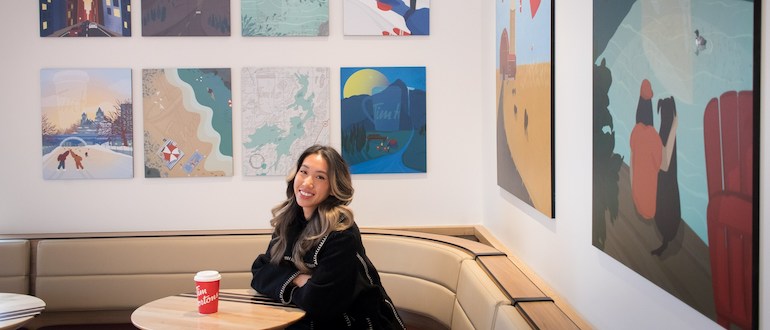“Team work makes the dream work,” is a saying that couldn’t be any truer in the restaurant industry. The ability to work together as a team plays an integral part of your restaurant’s success. And it’s not just working together with your staff that’s important. It’s also essential to seek out restaurant partnerships externally as well, as they give you an opportunity to tap into another businesses’ built-in audience and advertise to potential new customers. It’s just a matter of finding the right partner to become a part of your restaurant marketing strategy.
So how can you create successful restaurant partnerships to help push your business in the right direction? You’re about to find out. To help you craft a plan for creating a successful restaurant partnership, we’ll walk you through the following:
- What is a restaurant partnership?
- The benefits of a restaurant partnership
- 4 tips for finding the right partnership for your restaurant
- 6 examples of restaurant partnerships
What Is a Restaurant Partnership?
Let’s start by defining what a restaurant partnership is and answering the question of what is partnership marketing exactly.
A restaurant partnership is a collaboration between your business and another brand or business to meet a shared goal or achieve a set objective, as dictated by your marketing or brand management strategy. Your partner can be another restaurant, small business, chef, celebrity, or brand.
The Importance of Having Restaurant Partnerships
So, now that we’ve covered what is partnership marketing, let’s dive into why restaurant partnerships are so important.
Marketing partnerships are key to helping you achieve the goals you have set for your restaurant. Whether you’re looking to boost sales, increase your brand awareness on social media, introduce and launch new products, or even enter a new geographical market, partnerships in restaurant business are crucial. Collaborating and partnering with another brand or business with specific expertise and knowledge, as well as access to an untapped market, can help your restaurant move one step closer to meeting your objectives.
4 Tips for Finding the Right Partnership for Your Restaurant
We’ve established that having restaurant partnerships can be a critical part of your restaurant’s success and can serve as one of your restaurant marketing strategies. So, how exactly do you find the right partnerships for your business in the first place? Here are four tips for crafting the right partnership.
1. Define Your Goals
Before you start looking for a new partner, first things first is to determine what are your restaurant’s goals and what you want to achieve through this partnership. Whether that’s increasing your followers on your restaurant social media platforms, giving back to the community, or attracting a brand new target audience for your recently opened location, you need to set a measure of success.
Let’s say your goal is to attract a younger demographic by raising your brand’s digital profile. Dunkin Donuts did exactly that by partnering with Charli D’Amelio, a TikTok sensation back in 2020, to launch D’Amelio’s go-to coffee order as a limited-time menu item called “The Charli.” This clever pairing helped Dunkin’ raise its profile among D’Amelio’s young audience and helped the chain go viral at the time. Your restaurant can follow a similar lead by making strategic influencer partnerships to blow up your brand on social media.
2. Choose the Right Type of Partner
Attaching yourself to another brand or business, even for a short-term marketing campaign, can have a lasting impact on the minds of your current and potential customers, so it’s important to choose the right one. Here are three tips to narrowing down a potential partner:
- Based on your goals, ask yourself what type of partner are you looking to strike a deal with? Whether that’s a celebrity, another restaurant, a distillery or brewery, local food supplier or distributor, a retail business, or another brand or business. Depending on the type of partner you choose, they can offer you different strategic benefits, such as financial or technology resources, access to a specific target audience, or level of expertise in various areas.
- To help you shortlist who to potentially partner with, ask yourself if this brand or business shares the same values as you. This is important, because you don’t want to be associated with and work with a brand or business that does not align with your restaurant’s mission. Working with a partner with the same values can make the decision making process smoother as well. This is because partners with similar values can assess choices quicker and likely have a more trusting relationship, which can make decision-making more efficient as a result.
- And most importantly, to avoid a public relations nightmare, do your research on who you choose to do business and partner with. By doing this, you can weed out potential partners with “skeletons in the closet” or conflicts of interest.
At the end of the day, you want to ensure this partnership will attract attention and be talked about in a positive light, not a negative one. Therefore, taking the time to choose the right partner from the get-go can save you and your staff time, energy, and money from dealing with any negative backlash
3. Leverage Networking and Social Media
Finding the right partner in a sea full of options can be difficult. However, to ease the searching process, you can tap into your network and leverage the connections you already have made in the restaurant industry. Reach out to friends, family, former colleagues, or past industry partners. If you’re newer to the restaurant industry and don’t have many established connections, turn to networking opportunities, such as a local event or conferences geared toward restaurant operators.
Another great way to seek connections is to leverage the power of social media. For example, LinkedIn provides a plethora of opportunities to connect and reach out to potential contacts for brands and businesses who you may not normally cross paths with in real life. You can also leverage LinkedIn and Facebook to join any relevant groups that give you opportunities to connect with those in and adjacent to the restaurant industry.
4. Deep Dive Into Potential Partners’ History and Experience
When you find a potential business to work with for a marketing campaign, look into their history and experience with partnering with restaurants.
For example, if you’re working towards only serving locally sourced foods and would like to promote that to your target audience, partnering with a local celebrity or influencer who is an advocate for environmental sustainability, and has a passion for food, can be a great way to improve your credibility among eco-savvy consumers.
6 Examples of Successful Restaurant Partnerships
So, what exactly makes a successful marketing partnership? Here are six examples of restaurant partnerships that have been well-executed and that you can replicate in your business.
Alo x Aburi Hana
Let’s kick it off with an example of partnerships between restaurant businesses. One Michelin star awarded restaurant, Alo, located in Toronto, Ontario, recently launched a unique collaboration with another high-end one Michelin-starred Toronto restaurant, Aburi Hana. As part of this partnership, Chef Patrick Kriss from Alo and Chef Ryusuke Nakagawa from Aburi Hana created an exclusive 10-course dining experience blending contemporary French cuisine with modern Kyō-Kaiseki cuisine. This experience was available for two evenings, one at Alo’s and one at Aburi Hana, for guests to dine-in.
This example shows that partnerships between restaurant businesses – which you may normally consider your competition – can actually be a very effective restaurant marketing strategy. Both Alo and Aburi Hana were able to expand their market reach by getting regular and new customers to try each of their dining experiences. In this case, a cross-collaboration between two restaurants with a similar target audience base shows you can mutually benefit from a partnership with your competition to boost your sales, as well as increase brand awareness.

Image Source: Newswire
Tim Hortons x Toronto Artist Av Wu
Continuing with the example of Canadian restaurant partnerships, a true Canadian marketing partnership was born when Tim Hortons teamed up with local Toronto artist Av Wu. Av Wu created a collection called “Coffee Styles” that features 10 pieces inspired by Canadian nature landmarks, such as the Rocky Mountains, and the significant impact Tim Horton’s as a brand has had on Canadians for several decades.
The takeaway here is that choosing a partner that aligns with your brand image can promote authenticity and improve your brand image. Tim Hortons’ Canadian heritage is central to its brand, so partnering with a local Toronto artist, Av Wu, aligned well with the company’s vision and reinforced its role in Canadian culture. It also shows the brand’s commitment to supporting the arts and engaging with the community, while benefiting from having art pieces to display across its locations.
Oji Seichi x Maitreyi Ramakrishnan
Oji Seichi, a local Ramen restaurant in the East End of Toronto, collaborated with Maitreyi Ramakrishnan, the Netflix star of Never Have I Ever, to present “Ramen-Krishnan,” which is a menu collaboration for a limited-time ramen and ice cream.
This collaboration between Oji Seichi and Ramakrishnan demonstrates that partnering with a celebrity who genuinely loves your product can add a layer of authenticity to your brand and your offerings. As a result of this, Oji Seichi was able to generate buzz for its products among fans of Ramakrishnan and the Tamil community, encouraging them to visit its establishment to try the limited-time products.
Taco Bell x Milk Bar
Another example of a successful restaurant partnership is Christina Tosi, owner of NYC bakery Milk Bar, who collaborated with Taco Bell in 2022 to launch a unique dessert called the “Strawberry Bell Truffle”, which was only available in a few Milk Bar locations and one Taco Bell location.
This partnership demonstrates that collaborating with a business that has a wealth of resources, experience, and familiarity with testing and launching new limited time items can be beneficial and give you a leg up on your own product development. When pursuing this type of partnership, be sure to conduct in-depth research and look for a partner that has extensive R&D experience and a wealth of expert knowledge that can significantly expedite the product development process.
Panda Express x Hot Ones
Well-known Chinese fast food chain, Panda Express, partnered with the popular YouTube channel Hot Ones to spice up customers’ lives with its new blazing bourbon chicken menu item. This dish featured Panda Express’ crispy boneless chicken and vegetables, along with a sweet and spicy bourbon sauce. So, where does the heat come from? The Hot Ones Last Dab Apollo hot sauce, of course!
This partnership demonstrates that you can further capitalize on some of your most popular items by taking it up a notch and partnering with a brand that already has a loyal built-in audience. Hot Ones has a built-in fan base of loyal consumers who would love to try anything the brand is associated with. Therefore, partnering with Hot Ones gives Panda Express access to a whole new audience of customers. Meanwhile, Hot Ones gets to tap into Panda Express’ nationwide distribution and make its Last Dab Apollo hot sauce accessible to more customers.
Chipotle x Street Fighter 6
The final example of a restaurant partnership that can serve as inspiration for your own partner marketing efforts is between the popular fast casual restaurant chain Chipotle and fan-favorite game Street Fighter 6. According to a Chipotle press release, “Chipotle will be the first restaurant brand to give Street Fighter 6 players the opportunity to earn Fighter Coins through digital entree purchases made on the Chipotle app and Chipotle.com.”
Chipotle partnering with Street Fighter 6 is a cross-industry collaboration example where two wildly different businesses have joined forces. With Chipotle cleverly tapping into built-in audiences outside of the restaurant industry, specifically the fighting gaming industry, this gives the restaurant brand access to an audience it may not normally have a lot of exposure to For example, according to a Digiday article, Chipotle has “the ability to advertise directly on PlayStation Network,” which is a unique advertising platform. This shows that even in a competitive industry, you can look for unexpected partnerships as a channel to reach a new audience.
With these six examples of successful partnerships and a restaurant partnership agreement template, you’re now equipped to tackle the world of restaurant marketing partnerships and create strategic partnerships of your own. Best of luck in your restaurant partnerships journey!
Free social media templates for your restaurant
Sign up for our free weekly TouchBistro Newsletter







